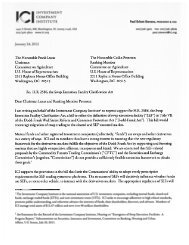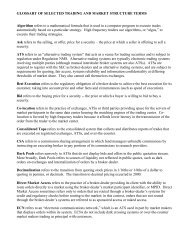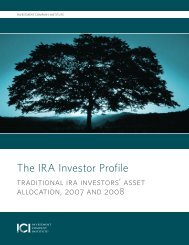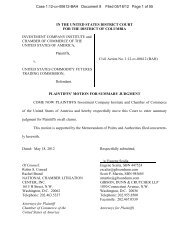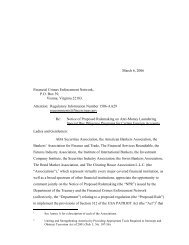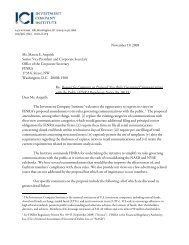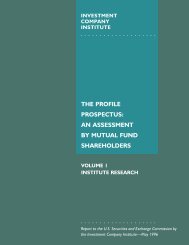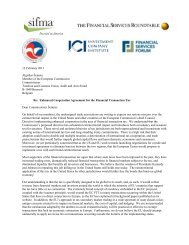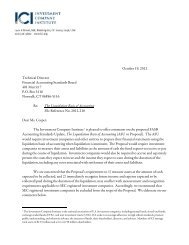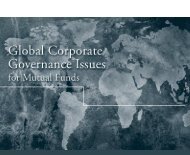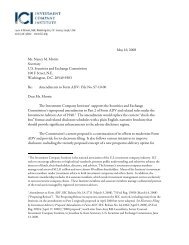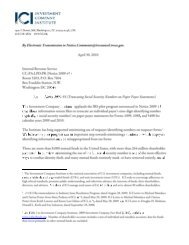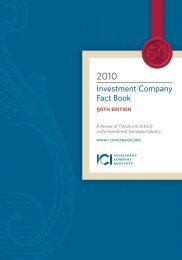Understanding Shareholders' Use of Information and Advisers (pdf)
Understanding Shareholders' Use of Information and Advisers (pdf)
Understanding Shareholders' Use of Information and Advisers (pdf)
- No tags were found...
Create successful ePaper yourself
Turn your PDF publications into a flip-book with our unique Google optimized e-Paper software.
THE PRE-PURCHASE PROCESS<strong>Information</strong> RequirementsA wealth <strong>of</strong> information from a variety <strong>of</strong> sources is availableto consumers considering a mutual fund purchase. Investmentinformation providers include pr<strong>of</strong>essional financial advisers,newspapers, magazines, investment newsletters, ranking services,<strong>and</strong>, <strong>of</strong> course, mutual fund companies. The U.S.Securities <strong>and</strong> Exchange Commission (SEC) requires mutualfunds to provide certain information to investors before sharesare purchased. 7To determine the information that is important to consumersin fund purchase decisionmaking, respondents wereasked to indicate which <strong>of</strong> 20 separate pieces <strong>of</strong> investmentinformation they considered before making their most recentfund purchases. Respondents typically said they reviewed 13<strong>of</strong> the 20 items <strong>of</strong> information. The items most frequentlyconsidered by respondents were a fund’s risk level, totalreturn, <strong>and</strong> the reputation <strong>of</strong> the fund company <strong>of</strong>fering afund. Roughly nine out <strong>of</strong> ten respondents cited these items. 8The items <strong>of</strong> information that the majority <strong>of</strong> respondents didnot consider before their most recent fund purchase were afund’s portfolio turnover rate, the portfolio manager’s pr<strong>of</strong>essionalbackground, <strong>and</strong> the availability <strong>of</strong> an 800 telephonenumber <strong>and</strong> 24-hour access.Respondents who had consulted a pr<strong>of</strong>essional financialadviser <strong>and</strong> those who had not reviewed a similar amount <strong>of</strong>information before purchasing their most recent mutualfunds. The median number <strong>of</strong> items considered by bothgroups was 13. The mix <strong>of</strong> items reviewed by these two groupswas also not too different, with fund risk <strong>and</strong> return being thetwo items both groups most frequently considered. Morerespondents who had consulted a pr<strong>of</strong>essional financialadviser, however, said they considered a fund manager’s tenure<strong>and</strong> pr<strong>of</strong>essional background than did respondents who hadnot consulted a pr<strong>of</strong>essional financial adviser. More respondentswithout a pr<strong>of</strong>essional financial adviser reviewed fundsales charges, the availability <strong>of</strong> an 800 telephone number forcustomers, <strong>and</strong> the availability <strong>of</strong> 24-hour access (Figure 17).Respondents who effectively leave all fund investmentdecisions to a pr<strong>of</strong>essional financial adviser reviewed feweritems <strong>of</strong> information before making their most recent fundpurchase than did shareholders who use advisers but take anactive role in the fund purchase process. For example, themedian number <strong>of</strong> items considered by respondents whoeffectively delegate all fund purchase decisions to an adviserwas 11, compared with a median <strong>of</strong> 14 for respondents whoeither tell their advisers what to purchase or work withan adviser to select a fund investment (see Figure 47 inAppendix B).Sources <strong>of</strong> <strong>Information</strong>Respondents typically consulted two information sourcesbefore making their most recent fund purchase. Over 50percent mentioned a pr<strong>of</strong>essional financial adviser <strong>and</strong> anarticle from a newspaper, magazine, or investment newsletter.Forty-six percent <strong>of</strong> respondents indicated using mutual fundprospectuses <strong>and</strong> annual reports as pre-purchase informationsources. 9 Thirty percent cited friends, family, <strong>and</strong> businessassociates, <strong>and</strong> 20 percent pointed to fund company newslet-7Investors purchasing a mutual fund from a sales representative can receive the prospectus, which contains the items that must be communicated to prospectiveshareholders, with the confirmation statement that verifies the purchase <strong>of</strong> fund shares.8Two other Institute studies—The Pr<strong>of</strong>ile Prospectus: An Assessment by Mutual Fund Shareholders (1996) <strong>and</strong> Shareholder Assessment <strong>of</strong> Risk Disclosure Methods(1996)—asked recent buyers <strong>of</strong> stock or bond funds to identify the information they reviewed before making their most recent fund purchases. In both <strong>of</strong> thesestudies, a fund’s risk level, total return, investment goals, types <strong>of</strong> companies invested in, <strong>and</strong> annual fees were the five most frequently cited items <strong>of</strong> information.(Reputation <strong>of</strong> the fund company was not asked in either study.) However, the proportions citing these items in this report were higher than those citing theseitems in The Pr<strong>of</strong>ile Prospectus: An Assessment by Mutual Fund Shareholders <strong>and</strong> Shareholder Assessment <strong>of</strong> Risk Disclosure Methods. For example, 90 percent <strong>of</strong> therespondents in this study cited a fund’s level <strong>of</strong> risk, whereas 68 percent <strong>of</strong> the respondents in The Pr<strong>of</strong>ile Prospectus: An Assessment by Mutual Fund Shareholders<strong>and</strong> 69 percent <strong>of</strong> the respondents Shareholder Assessment <strong>of</strong> Risk Disclosure Methods mentioned this item. The explanation appears to lie in methodological differences.In-person interviews were used to collect the data for The Pr<strong>of</strong>ile Prospectus: An Assessment by Mutual Fund Shareholders <strong>and</strong> Shareholder Assessment <strong>of</strong> RiskDisclosure Methods, whereas the data collected for this survey was gathered through telephone interviews. In the in-person interviews, respondents were presentedwith an exhibit listing a variety <strong>of</strong> information items <strong>and</strong> were asked to select those items that they had reviewed. Respondents to the telephone survey, clearly,could not be presented with the list <strong>of</strong> items. Rather, each item was read to the telephone survey respondents, after which they were asked whether they consideredthat item.9In The Pr<strong>of</strong>ile Prospectus: An Assessment by Mutual Fund Shareholders, 50 percent <strong>of</strong> respondents indicated using a mutual fund prospectus as a source <strong>of</strong> prepurchaseinformation, <strong>and</strong> 29 percent cited annual reports.20



